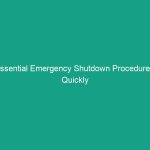Introduction
As winter approaches, the changing weather conditions pose unique challenges for Workplace Safety. The Health, Safety, and Environment (HSE) field emphasizes the importance of safeguarding employees from environmental Hazards, including those brought on by winter weather. Winter weather Safety tips are crucial for ensuring that workers remain safe and productive during the cold months. This article will explore various strategies and Best Practices to mitigate risks associated with winter weather, ensuring compliance with Safety Regulations and fostering a culture of proactive safety management.
Understanding the Risks of Winter Weather
Winter weather can introduce a variety of Hazards that affect both outdoor and indoor work environments. Understanding these risks is the first step toward implementing effective winter weather safety tips. Below, we outline the primary risks associated with winter conditions.
Slips, Trips, and Falls
One of the most common hazards during winter is slips, trips, and falls, primarily due to icy surfaces. According to the Bureau of Labor Statistics, slips and falls account for a significant percentage of workplace injuries during the winter months. Employers must take proactive measures, including:
- Regularly clearing snow and ice from walkways.
- Applying salt or sand to slippery surfaces.
- Establishing designated pathways for employees to follow.
Cold Stress
Prolonged exposure to cold temperatures can lead to cold stress, which includes conditions such as hypothermia and frostbite. Employees working outdoors or in unheated areas face the highest risk. To mitigate these risks, consider the following winter weather safety tips:
- Provide appropriate clothing, including insulated gloves, hats, and thermal layers.
- Encourage regular breaks in warm areas to allow body temperature recovery.
- Monitor weather conditions and adjust work schedules accordingly.
Vehicle Hazards
Winter weather significantly impacts driving conditions, increasing the risk of vehicle accidents for employees who travel for work. Employers can promote Safe Driving Practices by:
- Providing winter driving Training sessions.
- Encouraging employees to maintain their vehicles, including checking tires and fluids.
- Implementing a policy for inclement weather, such as remote work options or adjusted hours.
Regulatory Frameworks for Winter Weather Safety
Understanding the regulatory frameworks that govern Workplace Safety during winter weather is essential for compliance and risk management. The Occupational Safety and Health Administration (OSHA) provides guidelines that employers must follow to ensure employee safety.
osha Regulations
OSHA does not have specific regulations for winter weather but does require employers to provide a safe work environment. Key regulations related to winter weather safety include:
- General Duty Clause: Employers must keep the workplace free from recognized hazards.
- Personal Protective Equipment (PPE): Employers must provide appropriate PPE to protect against cold stress and other winter hazards.
- Recordkeeping and Reporting: Employers are required to report any workplace injuries, including those resulting from winter weather conditions.
State and Local Regulations
In addition to federal regulations, employers must also consider state and local laws that may impose additional requirements for winter safety. For instance, some states have specific laws regarding snow removal responsibilities for businesses. It’s crucial for employers to stay informed about these regulations to ensure compliance and protect their employees.
Best Practices for Winter Weather Safety
Implementing Best Practices is vital for safeguarding employees during winter months. Here are some effective strategies that can be employed:
Conduct Safety Training
Regular safety training sessions are essential for educating employees about potential winter hazards. Training should cover:
- Identifying hazardous conditions.
- Using PPE effectively.
- Emergency response Procedures in case of accidents.
Establish a Winter Safety Committee
Forming a dedicated winter safety committee can help focus efforts on mitigating winter-related risks. This committee can:
- Conduct risk assessments specific to winter conditions.
- Develop and implement safety protocols.
- Monitor compliance and effectiveness of Safety Measures.
Communication and Signage
Clear communication about winter safety is crucial. Employers should provide updated information on weather conditions and safety protocols through:
- Email alerts or text messages.
- Notices posted in common areas.
- Clear signage in Hazardous Areas indicating caution against icy conditions.
Case Studies: Successful Implementation of Winter Safety Measures
Real-world examples can illustrate the effectiveness of winter weather safety tips in reducing hazards and injuries. Here are two case studies highlighting successful strategies:
Case Study 1: Construction Company
A construction company faced numerous slip and fall incidents during winter months. To combat this, they implemented a comprehensive winter safety program that included:
- Daily inspections of work sites for icy patches.
- Mandatory winter boots for all workers.
- Regular safety briefings focusing on winter hazards.
As a result, the company saw a 60% reduction in winter-related injuries over two seasons, proving that proactive measures can significantly enhance Workplace Safety.
Case Study 2: Retail Store
A retail store located in a snowy region struggled with customer falls due to ice accumulation in parking lots. They took the following steps:
- Contracted a snow removal service to ensure immediate clearance after snowfalls.
- Installed heated mats at entry points to reduce ice formation.
- Placed warning signs indicating slippery surfaces.
These measures resulted in a notable increase in customer safety and satisfaction, demonstrating the importance of addressing winter hazards proactively.
Challenges in Implementing Winter Weather Safety Tips
While winter weather safety tips are essential, implementing them can pose challenges. Understanding these obstacles is crucial for developing effective strategies.
Budget Constraints
Many organizations face budget constraints that can limit their ability to invest in winter safety measures. This can lead to inadequate training, insufficient equipment, or lack of proper signage. Employers should prioritize safety in budget planning and look for cost-effective solutions, such as:
- Utilizing existing resources for training sessions.
- Investing in durable PPE that lasts multiple seasons.
- Collaborating with local safety organizations for shared training opportunities.
Employee Compliance
Even with the best training and resources, employee compliance can be a significant challenge. Some workers may neglect safety protocols, especially if they feel rushed or pressured to complete tasks. To enhance compliance, employers can:
- Encourage a safety-first culture where employees feel empowered to speak up about unsafe conditions.
- Implement incentives for those who consistently follow Safety Guidelines.
- Regularly review and reinforce the importance of adherence to safety protocols.
Future Trends in Winter Weather Safety
As climate change continues to affect weather patterns, winter weather safety will evolve. Understanding future trends can help organizations prepare and adapt. Here are some anticipated trends:
Increased Use of Technology
With advancements in technology, businesses are increasingly utilizing tools such as:
- Weather tracking apps to monitor conditions.
- AI-driven safety management systems that assess risks in real-time.
- Virtual reality (VR) for training employees on winter safety protocols in a controlled environment.
These technologies can lead to more effective safety measures and quicker responses to hazardous conditions.
Emphasis on Mental Health
Winter can also take a toll on mental health due to seasonal affective disorder (SAD) and increased stress from adverse weather conditions. Organizations are recognizing the importance of mental health support by:
- Providing access to counseling services.
- Creating initiatives that promote employee well-being during the winter months.
- Encouraging open discussions about mental health in the workplace.
Conclusion
As we navigate through winter, it is essential to prioritize safety by implementing effective winter weather safety tips. Understanding the risks, adhering to regulatory frameworks, and adopting best practices can significantly reduce hazards and ensure a safe working environment. By learning from case studies and addressing challenges proactively, organizations can foster a culture of safety that not only protects employees but also enhances productivity. Remember, safety is not just a policy; it’s a commitment. Let’s make this winter a safe one for everyone. Take the initiative to review and enhance your winter safety protocols today!


